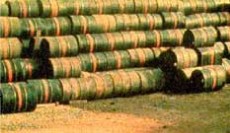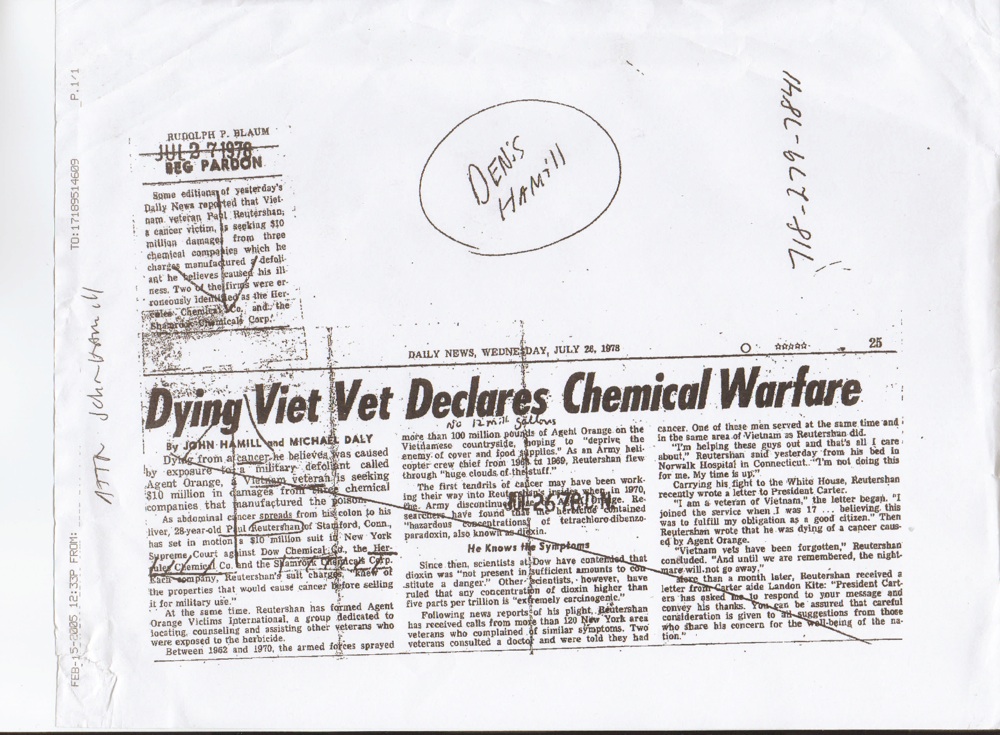Agent Orange
From the Department of Veterans Affairs:

What is Agent Orange?
Agent Orange was an herbicide, or defoliant, used in Vietnam to kill unwanted plant life and to remove leaves from trees which otherwise provided cover for the enemy. The name, “Agent Orange,” came from the orange stripe on the 55-gallon drums in which it was stored. Other herbicides, including Agent Purple, Agent White, and Agent Blue, were also used in Vietnam to a much lesser extent.
When and where was Agent Orange used in Vietnam?
Under Operation Ranch Hand, fifteen different herbicides were shipped to and used in Vietnam between January 1961 and 1971. Agent Orange accounted for over most of the herbicides sprayed in Vietnam. Agent Orange was used between January 1965 and April 1970. Herbicides other than Agent Orange were used in Vietnam prior to 1965, but to a very limited extent. The total area sprayed with herbicides between 1962 and 1965 was small, less than 7 percent of the total acreage sprayed during the Vietnam conflict. Rapid increases in the annual number of acres sprayed occurred from 1962 to 1967. The number of acres sprayed reached a maximum in 1967, leveled off slightly in 1968 and 1969, and declined rapidly in 1970 prior to the termination of spraying in 1971.
During this time more than 19 million gallons of herbicides were sprayed over 6 million acres, some of which were sprayed more than once. More than 3.5 million acres of South Vietnam approximately 8.5 percent of the country were sprayed one or more time. Spraying occurred in all 4 military zones of Vietnam.
Heavily sprayed areas included inland forests near the demarcation zone; inland forests at the junction of the borders of Cambodia, Laos, and South Vietnam; inland forests north and northwest of Saigon; mangrove forests on the southernmost peninsula of Vietnam; and mangrove forests along major shipping channels southeast of Saigon. Crop destruction missions were concentrated in northern and eastern central areas of South Vietnam.


Why are Vietnam veterans concerned about Agent Orange?
In the 1970’s some veterans became concerned that exposure to Agent Orange might cause delayed health effects. One of the chemicals in Agent Orange contained minute traces of a dioxin that caused a variety of illnesses in laboratory animals. More recent studies have suggested that the chemical may be related to a number of malignancies and other disorders.

What conditions have been “service-connected” based on evidence of an association with Agent Orange (or other herbicides used in Vietnam)?
The following conditions are now presumptively recognized for service-connection for Vietnam veterans based on exposure to Agent Orange or other herbicides: chloracne (a skin disorder), porphyria cutanea tarda, acute or subacute transient peripheral neuropathy (a nerve disorder), Type 2 diabetes and numerous cancers [non-Hodgkin’s lymphoma, chronic lymphocytic leukemia, soft tissue sarcoma, Hodgkin’s disease, multiple myeloma, prostate cancer, respiratory cancers (including cancers of the lung, larynx, trachea, and bronchus), and chronic lymphocytic leukemia].
In addition, Vietnam veterans’ children with the birth defect spina bifida are eligible for certain benefits and services. In 1999, VA announced that statutory authority would be sought for similar benefits and services for children with birth defects who were born to women Vietnam veterans.
For more information concerning Agent Orange, visit the United States Department of Veterans Affairs.
Below is an article written by John Hamill about one of the many effects of Agent Orange:
 “Dying Viet Vet Declares Chemical Warfare” by John Hamill
“Dying Viet Vet Declares Chemical Warfare” by John Hamill
CLICK HERE to read the article above (PDF format).
____________________________________________________________________________________________________
Citations
Arison III, H. Lindsey. “Statistical Summary of Herbicidal Warfare in Vietnam.” March 24, 2009.http://www.landscaper.net/agent2.htm (accessed May 10, 2009).
Brigham, Nancy. “National Lawyers Guild Internaional Committe.” 2007.http://www.nlginternational.org/report/pix/AO_Barrels.jpg (accessed 12 May 2009).
Combat Monsato, “Combat Monsato.” 2008.http://www.combat-monsanto.co.uk/IMG/jpg/agent_orange_vet.jpg (accessed 12 May 2009).
Common Dreams, “Common Dreams.” 2009.http://www.commondreams.org/files/article_images/agentorange_sprayed.jpg (accessed 12 May 2009).
United States Department of Veterans Affairs, “Agent Orange.” Updated on November 13, 2008.http://www1.va.gov/agentorange/ (accessed May 10, 2009).
The Environmental Agents Service, “Agent Orange Brief(2005), (accessed May 10, 2009).
_________________________________________________________________________________________________________
_________________________________________________________________________________________________________